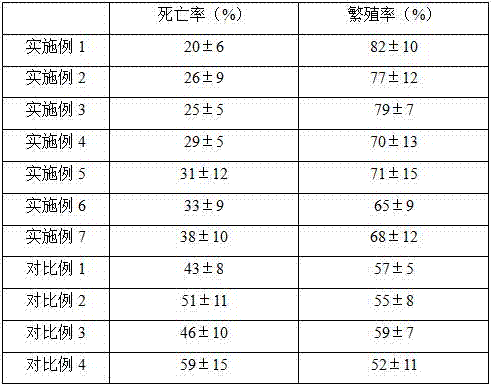Feed for gene editing laboratory mice
A technology of gene editing and experimental mice, which is applied to animal feed, animal feed, molding or processing of animal feed, etc., can solve problems such as low reproductive ability, fertility degradation, and death of experimental mice, so as to promote growth and reproduction significantly, enhance Disease resistance and the effect of reducing the incidence of gastrointestinal diseases
- Summary
- Abstract
- Description
- Claims
- Application Information
AI Technical Summary
Problems solved by technology
Method used
Image
Examples
preparation example Construction
[0020] It is found through research that the feed of the present invention has better efficacy than the feed made by the conventional method according to the following preparation method, which specifically includes the following steps: S1. Raw material preparation: After crushing corn, wheat, soybean meal and broken rice, carry out the preparation with the remaining raw materials Fully mixed; S2. Preparation and granulation: Put the mixed raw materials into the granulator, and make pellet feed under steam at 80-120°C; S3. Feed screening: Screen the prepared pellet feed to keep the particle size 11-13mm pellet feed with a length of 30-40mm; S4. Nutrition monitoring and packaging: sterilize the screened feed, and conduct nutritional, hygienic, and microbiological index tests, and package and store feed that meets the standards.
[0021] Unless otherwise specified, the raw materials are all commercially available materials.
[0022] The method of the present invention will be fu...
Embodiment 1
[0024] A feed for gene-edited experimental mice, which consists of the following components in parts by weight: 30 parts of corn, 15 parts of wheat, 20 parts of soybean meal, 12 parts of broken rice, 8 parts of fish meal, 3 parts of oil, 8.4 parts of yeast hydrolyzate, 1.2 parts of stone powder, 1 part of calcium hydrogen phosphate, 0.6 parts of complex minerals, 0.4 parts of multivitamins, 0.2 parts of methionine, and 0.2 parts of lysine.
[0025] The preparation method of the above-mentioned feed includes the following steps: S1. Raw material preparation: After pulverizing corn, wheat, soybean meal and broken rice, fully mixing with the remaining raw materials; S2. Modulating granulation: putting the mixed raw materials into a granulator, Make pellet feed under steam at 100-120°C; S3. Feed screening: screen the prepared pellet feed, and keep pellet feed with a particle size of 12mm and a length of 30-40mm; S4. Nutritional monitoring and packaging: screening Good feeds are te...
Embodiment 2
[0027] A feed for gene-edited experimental mice, which consists of the following components in parts by weight: 32.4 parts of corn, 13 parts of wheat, 19.6 parts of soybean meal, 12 parts of broken rice, 8.5 parts of fish meal, 2.5 parts of oil, 8.5 parts of yeast hydrolyzate, 1.1 parts of stone powder, 1 part of calcium hydrogen phosphate, 0.6 parts of complex minerals, 0.4 parts of multivitamins, 0.2 parts of methionine, and 0.2 parts of lysine.
[0028] The preparation method of above-mentioned feed is identical with embodiment 1.
PUM
 Login to View More
Login to View More Abstract
Description
Claims
Application Information
 Login to View More
Login to View More - R&D
- Intellectual Property
- Life Sciences
- Materials
- Tech Scout
- Unparalleled Data Quality
- Higher Quality Content
- 60% Fewer Hallucinations
Browse by: Latest US Patents, China's latest patents, Technical Efficacy Thesaurus, Application Domain, Technology Topic, Popular Technical Reports.
© 2025 PatSnap. All rights reserved.Legal|Privacy policy|Modern Slavery Act Transparency Statement|Sitemap|About US| Contact US: help@patsnap.com

